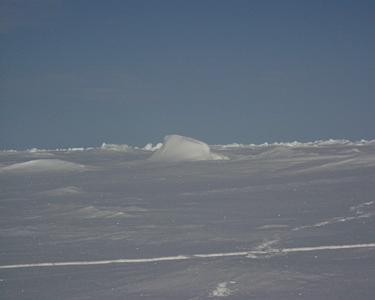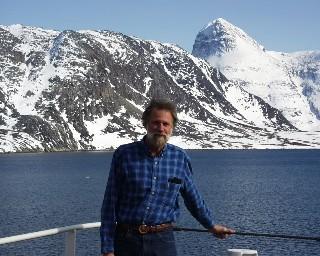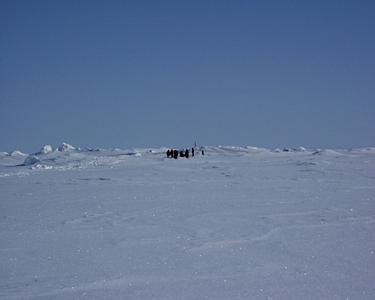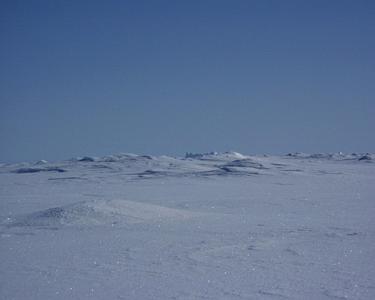9 May, 2000
Multi-year Ice and Progress Summary
DRAFT
May 9, 2000
Daily Data (20:30):
Lat. 6833.104809N
Long. 06103.438401W
Heading 19.436
Air Temp. -8.59C 16.54F
True Wind Dir. 110
True Wind Speed 9 knots
USCGC Healy Facts:
2200HP Bow Thruster and Bow Wash System
Cranes: 5 hydraulically operated, 100% coverage of working decks
Anti-roll Stabilization Tank
Inuit Language Lesson from Stevie Audlakiak and James Qillaq:
Kilalogauk (clay' la loo gahk): Narwhal
Kilalogauk Kaukotuk (clay' la loo gahk kaw co' tawk): White whale (as in
the white adult Beluga)
Kilalogauk Isotuak (clay' la loo gahk ee so' tah): Gray whale (as in the
small young Beluga whale)
Dear Everyone,
Multi-year softly rounded ridged ice that brings to mind a pristine white
free-form sculpture field spanning to infinity, view of an enormous and
glorious centuries-old iceberg classified as "Large" and a sunny, clear day
makes for what I call a "moment in time." I cannot imagine anything more
beautiful.
And the air. It is so pure, so invigorating. Ice crystals sparkle in it
while the surface snow powder glistens.
Jumping to every opportunity to go onto the ice floes and with enthusiasm I
cannot suppress, Terry Tucker, Co-Chief Scientist and my P.I. (Principle
Investigator) said to me the other day, "Sandi, you're really hooked on
this, aren't you?" I didn't miss a heartbeat before "I love it!" spouted
from my mouth. "They'll have to drag me kicking and screaming off the
Healy," I'm thinking to myself.
One month ago I never anticipated that I would find ice so fascinating and
icebreaker ice trials so interesting, stimulating. I'll never be able to
look at an ice cube again without wanting to slice it, place it on a crossed
polaroid light table and have a look. "What's its density?" I'll wonder as
I sip my iced tea, "What's its flexural strength?"
The Healy is hove-to (parked) since yesterday evening in our most scenic
location to date. I spent the morning on the Multi-year Ice floe assisting
with the recording of measurements and the collecting of snow samples.
There were a variety of activities occurring for data collection. Ice cores
were taken, measurements for profiling ice thickness, and snow samples
collected for density tests.
Vocabulary of the day:
From MANICE; Manual of Standard Procedures for Observing and Reporting Ice
Conditions, Canadian Ice Service, April 1994.
Old Ice: Sea ice which has survived at least one summer's melt.
Topographic features generally are smoother than first-year ice; it may be
subdivided into second-year and multi-year ice.
Second-year Ice: Old ice which has survived only one summer's melt.
Thicker and less dense than first-year ice, it stands higher out of the
water. In contrast to multi-year ice, summer melting produces a regular
pattern of numerous small puddles. Bare patches and puddles are usually
greenish-blue.
Multi-year Ice: Old ice which has survived at least two summer's melt.
Hummocks are smoother than on second-year ice and the ice is almost
salt-free. Where bare, this ice is usually blue in color. The melt pattern
consists of large interconnecting, irregular puddles and a well-developed
drainage system.
Weathered Ridge: Ridge with peaks slightly rounded and slope of sides
usually 30 to 40 degrees. Individual fragments are not discernible.
Very Weathered Ridge: Ridge with tops very rounded. Slope of sides usually
20 to 30 degrees.
Aged Ridge: Ridge, which has undergone considerable weathering. These
ridges are best described as undulations.
Hummock: A hillock of broken ice, which has been forced upwards by
pressure. May be fresh or weathered.
Bummock: The submerged volume of broken ice under the hummock forced
downwards by pressure.
Hummocked Ice: Ice piled haphazardly one piece over another to form an
uneven surface. When weathered it has the appearance of smooth hillocks.
Terry Tucker, Co-Chief Scientist for this phase of the Healy Ice Trial
studies, gave me permission to share the following summary he wrote about
our testing during the past week.
"Performance wise, the Healy has really proven herself. On a level
icebreaking test last Wednesday, we proceeded through 4.5 ft. of ice at 4.5
knots. While this ice was not of 100 psi flexural strength called for in
the design specification ...it was 50 - 60 psi, quite typical of late spring
Arctic conditions. To top that, on Sunday, the ship broke 5.5 feet of level
ice at slightly over 2 knots. Needless to say, we (including our
international parcticipants) have all been impressed with the ship's
icebreaking capabilities and maneuverability in ice.
Just as we were beginning to get cocky, however, Mother Nature showed us who
was really in charge. We happened to drive between two floes that were
actively ridging, and no amount of power could get us out for about 6 hours,
until the pressure eased. Since the hull was instrumented to measure
icebreaking impact loads, an excellent set of data was collected as the
ridge formed against the hull. We have also done a great deal of backing
and ramming to get through ridges, as any icebreaker must do.
Today, we conducted a backing and ramming test in a 3.5 m. thick multi-year
floe, and Healy made admirable progress. We were able to turn around in the
multiyear floe by demolishing an 8 - 9 m. thick ridge while making an area
large enough to allow the course reversal. It took 3 - 4 hours, but it was
an impressive feat, nonetheless." Terry Tucker
How large is the Large Iceberg outside my porthole (ship's round stateroom
window)? Robert Wolfe, Research and Development Officer of Transport Canada
in Ottawa; and Kaj Riska, Professor of Naval Architecture at Helsinki
University of Technology, Finland both calculated its size. I found Robert
and Kaj in the bridge tonight and they shared the essential data with me.
This time, I will not tell you the answer! Well, maybe sometime.
Refer back to my journal of April 28, 2000, "Beginning with Growlers" for
further information. Remember to assume a right angle triangle when making
your calculations and to determine the size in meters. The Coast Guard
personnel on duty in the Healy bridge provided the radar range of 0'.42
nautical miles from the ship. Using a sextant, the width and height were
determined. The width of the iceberg is 22 deg. 18 min. The height is 3
deg. 50 min. What is the size of this iceberg?
Best regards,
Sandra Kolb

A multi-year ice floe. photo by Sandra

Terry Tucker on the Healy. photo by Sandra

Terry Tucker in the Healy bridge. photo by Sandra

Coring multi-year ice. photo by Sandra

Terry Tucker. photo by Sandra

Multi-year ice floe. photo by Sandra
Contact the TEA in the field at
.
If you cannot connect through your browser, copy the
TEA's e-mail address in the "To:" line of
your favorite e-mail package.
|
